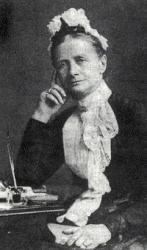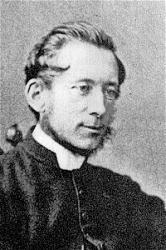Planning worship?
Check out our sister site, ZeteoSearch.org,
for 20+ additional resources related to your search.
- |
User Links
Search Results
Let the song go round the earth
Author: Sarah G. Stock Meter: 7.5.7.5.7.7 Appears in 44 hymnals Lyrics:
Let the song go round the earth,
Jesus Christ is Lord!
Sound his praises, tell his worth,
Be his Name adored;
Every clime and every tongue
Join the grand, the glorious song!
Let the song go round the earth!
From the eastern sea,
Where the daylight has its birth,
Glad, and bright, and free!
China's millions join the strains,
Waft them on to India's plains.
Let the song go round the earth!
Lands where Islam's sway
Darkly broods o'er home and hearth,
Cast their bonds away!
Let his praise from Afric's shore
Rise and swell her wide lands o'er.
Let the song go round the earth!
Where the summer smiles;
Let the notes of holy mirth
Break from distant isles!
Inland forests, dark and dim,
Icebound coasts give back the hymn.
Let the song go round the earth,
Jesus Christ is King!
With the story of his worth
Let the whole world ring!
Him creation all adore
Evermore and evermore.
Topics: Missions; Sunday Schools Missions; Parochial Missions Used With Tune: MOEL LLYS
Let the song go round the earth
Go, ye saints, to Bethlehem
Author: John Brownlie Meter: 7.5.7.5.7.7 Appears in 1 hymnal Lyrics:
Go, ye saints, to Bethlehem,
Ere the morning breaks,
Hear the song the angels sing
While the earth awakes,--
Go, and put your harps in tune,
For the praise of the Triune.
Go, ye saints, to Galilee,
When the noon is high,
Hear the voice of Wisdom speak
To the passers by,
See the work of mercy wrought,
Learn to labour as ye ought.
Go, and seek Gethsemane,
In its darkest shade;
See the sorrowing God-man there,
Sighing, prostrate laid;
Go, and pray "Thy will be done,"
With the agonizing Son.
105
Go, ye saints, to Calvary,
Where the flesh is torn;
See the power of sin o'erthrown
'Mid its shouts of scorn;
And, before the awful Cross,
Count the gain that comes from loss.
Go, ye saints, to Bethlehem
Every Morning the Red Sun
Author: Cecil F. Alexander Hymnal: The Cyber Hymnal #1338 Meter: 7.5.7.5.7.7 Lyrics: 1. Every morning the red sun
Rises warm and bright;
But the evening cometh on,
And the dark, cold night.
There’s a bright land far away,
Where ’tis never-ending day.
2. Every spring the sweet young flowers
Open bright and gay,
Till the chilly autumn hours
Wither them away.
There’s a land we have not seen,
Where the trees are always green.
3. Little birds sing songs of praise
All the summer long,
But in colder, shorter days
They forget their song.
There’s a place where angels sing
Ceaseless praises to their King.
4. Christ our Lord is ever near
Those who follow Him;
But we cannot see Him here,
For our eyes are dim;
There is a most happy place,
Where men always see His face.
5. Who shall go to that bright land?
All who do the right:
Holy children there shall stand
In their robes of white;
For that Heav’n, so bright and blest,
Is our everlasting rest. Languages: English Tune Title: ST. FAITH
Every Morning the Red Sun
Go, ye saints, to Bethlehem
Author: John Brownlie Hymnal: Hymns of the Russian Church #104 (1920) Meter: 7.5.7.5.7.7 Lyrics:
Go, ye saints, to Bethlehem,
Ere the morning breaks,
Hear the song the angels sing
While the earth awakes,--
Go, and put your harps in tune,
For the praise of the Triune.
Go, ye saints, to Galilee,
When the noon is high,
Hear the voice of Wisdom speak
To the passers by,
See the work of mercy wrought,
Learn to labour as ye ought.
Go, and seek Gethsemane,
In its darkest shade;
See the sorrowing God-man there,
Sighing, prostrate laid;
Go, and pray "Thy will be done,"
With the agonizing Son.
105
Go, ye saints, to Calvary,
Where the flesh is torn;
See the power of sin o'erthrown
'Mid its shouts of scorn;
And, before the awful Cross,
Count the gain that comes from loss.
Languages: English
Go, ye saints, to Bethlehem
Every morning the red sun
Hymnal: The Sarum Hymnal #276 (1869) Meter: 7.5.7.5.7.7
Every morning the red sun
Cecil Frances Alexander

1818 - 1895 Meter: 7.5.7.5.7.7 Author of "Every morning the red sun" in The Book of Common Praise As a small girl, Cecil Frances Humphries (b. Redcross, County Wicklow, Ireland, 1818; Londonderry, Ireland, 1895) wrote poetry in her school's journal. In 1850 she married Rev. William Alexander, who later became the Anglican primate (chief bishop) of Ireland. She showed her concern for disadvantaged people by traveling many miles each day to visit the sick and the poor, providing food, warm clothes, and medical supplies. She and her sister also founded a school for the deaf. Alexander was strongly influenced by the Oxford Movement and by John Keble's Christian Year. Her first book of poetry, Verses for Seasons, was a "Christian Year" for children. She wrote hymns based on the Apostles' Creed, baptism, the Lord's Supper, the Ten Commandments, and prayer, writing in simple language for children. Her more than four hundred hymn texts were published in Verses from the Holy Scripture (1846), Hymns for Little Children (1848), and Hymns Descriptive and Devotional ( 1858).
Bert Polman
==================
Alexander, Cecil Frances, née Humphreys, second daughter of the late Major John Humphreys, Miltown House, co. Tyrone, Ireland, b. 1823, and married in 1850 to the Rt. Rev. W. Alexander, D.D., Bishop of Derry and Raphoe. Mrs. Alexander's hymns and poems number nearly 400. They are mostly for children, and were published in her Verses for Holy Seasons, with Preface by Dr. Hook, 1846; Poems on Subjects in the Old Testament, pt. i. 1854, pt. ii. 1857; Narrative Hymns for Village Schools, 1853; Hymns for Little Children, 1848; Hymns Descriptive and Devotional, 1858; The Legend of the Golden Prayers 1859; Moral Songs, N.B.; The Lord of the Forest and his Vassals, an Allegory, &c.; or contributed to the Lyra Anglicana, the S.P.C.K. Psalms and Hymns, Hymns Ancient & Modern, and other collections. Some of the narrative hymns are rather heavy, and not a few of the descriptive are dull, but a large number remain which have won their way to the hearts of the young, and found a home there. Such hymns as "In Nazareth in olden time," "All things bright and beautiful," "Once in Royal David's city," "There is a green hill far away," "Jesus calls us o'er the tumult," "The roseate hues of early dawn," and others that might be named, are deservedly popular and are in most extensive use. Mrs. Alexander has also written hymns of a more elaborate character; but it is as a writer for children that she has excelled.
- John Julian, Dictionary of Hymnology (1907)
===============
Alexander, Cecil F., née Humphreys, p. 38, ii. Additional hymns to those already noted in this Dictionary are in common use:—
1. Christ has ascended up again. (1853.) Ascension.
2. His are the thousand sparkling rills. (1875.) Seven Words on the Cross (Fifth Word).
3. How good is the Almighty God. (1S48.) God, the Father.
4. In [a] the rich man's garden. (1853.) Easter Eve.
5. It was early in the morning. (1853.) Easter Day.
6. So be it, Lord; the prayers are prayed. (1848.) Trust in God.
7. Saw you never in the twilight? (1853.) Epiphany.
8. Still bright and blue doth Jordan flow. (1853.) Baptism of Our Lord.
9. The angels stand around Thy throne. (1848.) Submission to the Will of God.
10. The saints of God are holy men. (1848.) Communion of Saints.
11. There is one Way and only one. (1875.) SS. Philip and James.
12. Up in heaven, up in heaven. (1848.) Ascension.
13. We are little Christian children. (1848.) Holy Trinity.
14. We were washed in holy water. (1848.) Holy Baptism.
15. When of old the Jewish mothers. (1853.) Christ's Invitation to Children.
16. Within the Churchyard side by side. (1848.) Burial.
Of the above hymns those dated 1848 are from Mrs. Alexander's Hymns for Little Children; those dated 1853, from Narrative Hymns, and those dated 1875 from the 1875 edition of Hymns Ancient & Modern.
Several new hymns by Mrs. Alexander are included in the 1891 Draft Appendix to the Irish Church Hymnal.
--John Julian, Dictionary of Hymnology, Appendix, Part II (1907)
=============
Alexander, Cecil F. , p. 38, ii. Mrs. Alexander died at Londonderry, Oct. 12, 1895. A number of her later hymns are in her Poems, 1896, which were edited by Archbishop Alexander.
--John Julian, Dictionary of Hymnology, New Supplement (1907)
See also in:Hymn Writers of the Church
Cecil Frances Alexander
John Bacchus Dykes

1823 - 1876 Meter: 7.5.7.5.7.7 Composer of "LANDSDOWNE" As a young child John Bacchus Dykes (b. Kingston-upon-Hull' England, 1823; d. Ticehurst, Sussex, England, 1876) took violin and piano lessons. At the age of ten he became the organist of St. John's in Hull, where his grandfather was vicar. After receiving a classics degree from St. Catherine College, Cambridge, England, he was ordained in the Church of England in 1847. In 1849 he became the precentor and choir director at Durham Cathedral, where he introduced reforms in the choir by insisting on consistent attendance, increasing rehearsals, and initiating music festivals. He served the parish of St. Oswald in Durham from 1862 until the year of his death. To the chagrin of his bishop, Dykes favored the high church practices associated with the Oxford Movement (choir robes, incense, and the like). A number of his three hundred hymn tunes are still respected as durable examples of Victorian hymnody. Most of his tunes were first published in Chope's Congregational Hymn and Tune Book (1857) and in early editions of the famous British hymnal, Hymns Ancient and Modern.
Bert Polman
John Bacchus Dykes


 My Starred Hymns
My Starred Hymns


